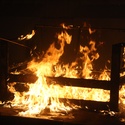In New Zealand, we have a number of house fires, fuelled by the things we have in our houses. Our furniture is flammable and often causes fires to burn quickly and fiercely.
Fire engineers Charley Fleischmann and Mike Spearpoint have been thinking carefully about these fires and are working on ways they can help save people’s lives.
Most things will burn. We can’t stop the burning, but if we can slow the fire down, it will give people a chance to get out of a house or building.
Couches and chairs are partly made up of fabrics (coverings) and foams (the soft padding in the middle). Charley and Mike are investigating these materials. First, they need to see how quickly and how fiercely different types of fabrics and foams burn – are these materials easy to ignite? They investigate the effects of burning in combinations of fabrics and foams, and then they try different things to slow down the burning.
Adding chemicals to foam
One of the things that can be done is to change the way something burns – make it burn more slowly. Adding chemical fire retardants to the materials slows down the burning.
Chemicals have been added to some of the foams that the fire engineers are investigating. These foams are called combustion-modified foams.
The chemicals interfere with the combustion process, making the foam difficult to ignite and, if it does ignite, making it difficult to burn. It burns more slowly.
This works really well in the early stages of a fire, but if the fire is already well established, the chemical retardants are not that effective.
Fabric coverings
Charley and Mike are also investigating the fabric coverings on our couches and chairs. A lot of coverings are inexpensive, but highly flammable. These coverings are often oil or hydrocarbon based and burn very easily and quickly.
The fire engineers have found that natural materials such as wool, cotton and leather are difficult to burn. For example, fire has trouble penetrating wool fibres so it tends to just char. The charred layer is difficult to burn and provides a protective barrier between the fire and the foam.
Chemical retardants can be added to these natural materials to make them even more fire-resistant. The problem is that natural fabrics are expensive. Chemical retardants are also expensive, and adding them to furniture increases the total cost of the furniture.
Leather is another natural fabric that is even more difficult to ignite and burn than wool, but it is also very expensive for people to buy.
Interliners
Interliners are fire-retardant materials that are placed between the outer fabric and the foam. It means the fire burns through the top fabric but is slowed down by the interliner. (It is a requirement that all aircraft have interliners in the seats.)
Fire engineers are testing interliners to see which ones are the most effective. Charley and Mike’s main aim is to slow the burning down to give people time to escape.
Nature of Science
Decisions are not always made according to science but depend heavily on politics, which include finances and social conventions.
Related content and activity idea
Fire behaviour explores the variables that influence fire. Ressearchers are also looking into fire behaviour in the outdoors.
Use the activity Ethics in fire science to help develop critical thinking skills through ethical discussions.







